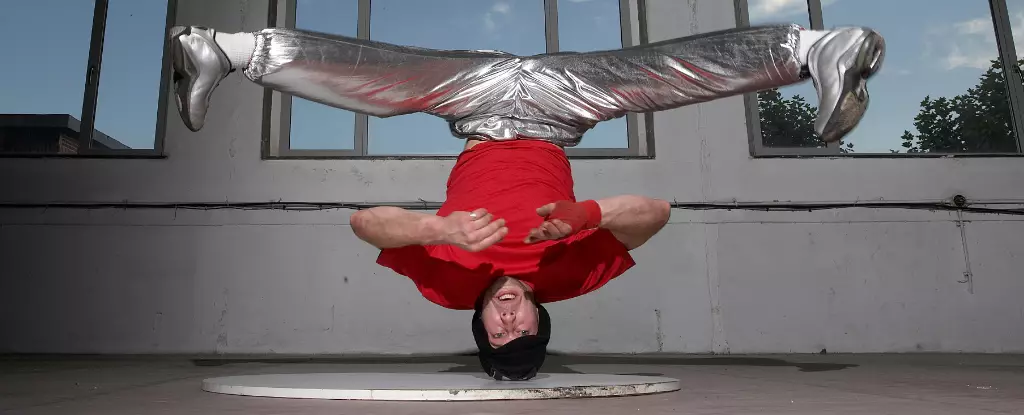For those who grew up in the 1990s, *Coneheads*, a film that humorously explored the lives of extraterrestrial beings with distinctly conical heads, stands as a cultural touchstone. Its impact transcended mere entertainment, becoming a symbol of that vibrant era. However, an unusual physical ailment commonly encountered by breakdancers has inadvertently turned the concept of a “conehead” into a real medical phenomenon, significantly affecting both their performance and overall health.
A 2024 medical case report has brought to light a peculiar condition known colloquially as the “headspin hole,” specifically affecting seasoned breakdancers. This condition manifests as a cone-shaped protrusion on the scalp, arising after years of performing intricate headspins—a hallmark move in breakdancing. A notable case featured a breakdancer with 19 years of experience suffering from this affliction, which is more formally referred to as “breakdancer bulge.”
The mechanics behind this unusual phenomenon involve the body’s adaptive responses to repetitive physical trauma. As breakdancers spin on their heads, the epicarneal aponeurosis, a fibrous layer of tissue that spans the skull, undergoes thickening. Additionally, the accumulation of fatty tissue forms as a defensive measure against potential injuries to the delicate skull bones.
Interestingly, the repercussions of excessive headspinning extend beyond just cosmetic deformities. Approximately 30 percent of breakdancers report experiences of hair loss and inflammation of the scalp, conditions exacerbated by the continuous friction and pressure experienced during their routines. This insight serves as a reminder that the dedication exhibited by breakdancers often comes with unintended consequences, compelling them to weigh the cost of their passion for the art against their health.
While the cone-shaped lump is indeed alarming, it pales in comparison to the other potential injuries associated with breakdancing. Common ailments include severe injuries to the wrists, knees, hips, and ankles. Moves like the “windmill” or “backspin” can lead to bursitis, which is inflammation affecting the protective fluid-filled sacs around the spinal vertebrae. The breadth of physical burdens breakdancers face reinforces the need for a deeper understanding of the injury landscape within this high-stakes sport.
Serious injuries in breakdancing can result from unfortunate miscalculations or unsafe practices. A particularly harrowing account involves a dancer who sustained a broken neck, an incident from which they fortunately emerged without lasting complications. In more severe cases, like that of Ukrainian breakdancer Anna Ponomarenko, dancers can experience debilitating conditions such as pinched nerves, which can lead to temporary paralysis. Despite these challenges, Ponomarenko’s remarkable recovery enabled her to represent Ukraine in the Paris 2024 Olympics, embodying the resilience that characterizes many in this community.
Like many physical pursuits, taking preventative actions can significantly diminish injury risks in breakdancing. Utilizing protective gear, awareness of proper technique, and allowing sufficient recovery time can play a vital role in safeguarding dancers. However, the culture surrounding breakdancing often involves a certain bravado that can overshadow the importance of injury prevention practices.
The notion of a “cone-shaped” head is not exclusive to the realm of breakdancers. Interestingly, neonatal medicine also notes its occurrence among newborns, who may emerge with conical skull shapes due to the pressures experienced during birth. This condition, along with various others such as caput succedaneum—fluid pooling under the skin—typically resolves itself within days.
In some instances, particularly with vacuum-assisted deliveries, newborns can exhibit more pronounced lumps from blood vessel ruptures, often referred to as cephalohematomas. Such phenomena can present themselves with varying severity and may require observation but often correct themselves without intervention, offering reassurance to concerned parents.
In a more complex medical scenario, the condition of craniosynostosis—a fusion of skull plates occurring in approximately one in every 2,000-2,500 live births—can lead to unique head shapes. While surgical intervention may be necessary to prevent restrictions in brain growth, early diagnosis is critical. More often than not, discerning when to seek medical advice can shape a child’s developmental future.
As amusing as the term “conehead” may evoke nostalgia for some, the underlying implications of injuries faced by breakdancers—or in newborns—serve as profound reminders of the body’s complex responses. Whether through breakdancing or childbirth, understanding the biological and medical narratives surrounding these conditions fosters a greater appreciation for human resilience, particularly when faced with extraordinary challenges. As the world of breakdancing continues to evolve, prioritizing health and safety will remain paramount for those dedicated to this dynamic sport.


Leave a Reply